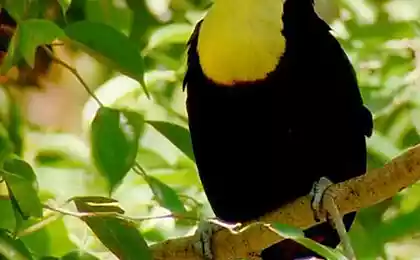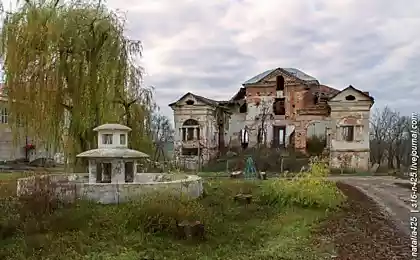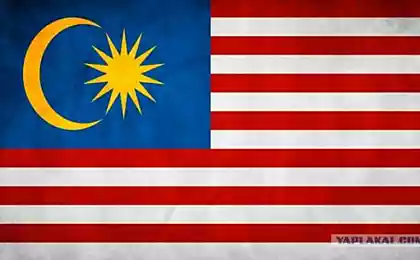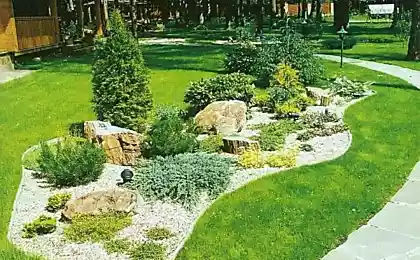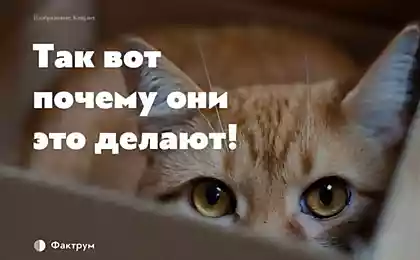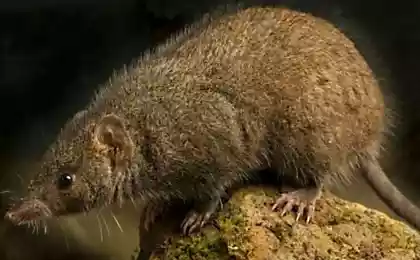671
Peacocks - fairest of birds
9 ph + text
Peacock - a bird which at all times was called beautiful. Iridescent blue-green plumage, a luxury long oculate fan of feathers, whip of feathers with tiny "eyes" on the head, long neck, an important step - all great peacock.

4000 years ago in ancient Babylon, Persia and Egypt, have spared no money to decorate their gardens of these wonderful birds. And they had to take them from a distance, along the Silk Road from India. It was there, in the jungle and in the bushes along the river valleys, is the birthplace of peacocks.
2
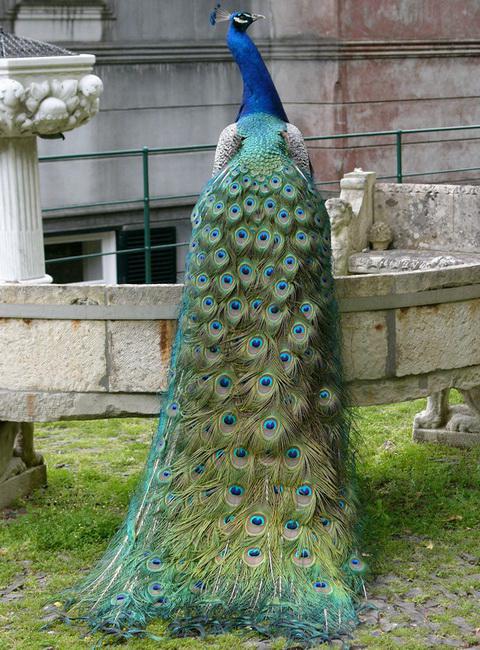
In Greece, Alexander the Great brought the peacocks from the Indian campaign. And then we began to breed peacocks in ancient Rome. And it not so proved troublesome thing - quickly breed in captivity regal birds and fried ... fell on the tables of Roman nobles.
3

In medieval Europe, breeding peacocks were not engaged, so this bird has become a rarity, was expensive, and on the dinner tables appeared only in the richest homes as evidence of the unprecedented generosity of the owner.
Then we have developed conflicting opinions about the peacock feathers.
Residents of Southern Europe believed that a spot on peacock pen is the "eye of the Lord", bringing happiness and good luck. In northern Europe, on the contrary, believed that with the peacock feathers look "devil eyes" that can bring misfortune to the one who owns them.
Hence, perhaps, the tales of ill-fated re Firebird, which, as he wrote in Yershov "Humpbacked Horse", "a lot of restlessness bring it with him ...."
4
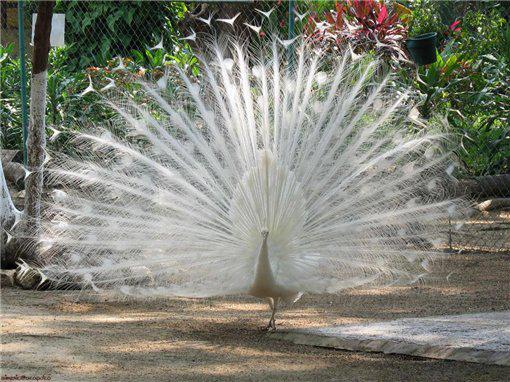
In India, the peacock - the sacred bird. Kill the peacock - then the wrath of the gods, because this bird is devoted to Krishna, one of the most important Hindu gods. That's peacocks roam freely over cultivated fields, eating a sacrificial portion of the harvest. Even in urban India wild peacocks feel good, eagerly eating handouts devout Hindus and generous tourists.
5
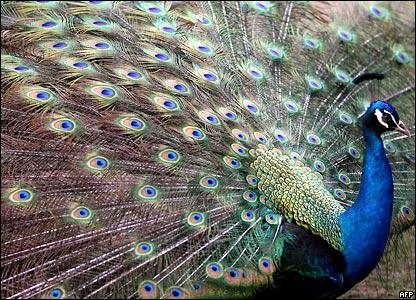
And Peacock is considered the master of rain, much desired for hot India. Peacock Creek in India is perceived as "minhao", which translated means: "Rain, Go!" And indeed, as soon as the male peacocks often begin to cry, the rainy season begins.
This mystical coincidence is explained very simply - peacocks mating season, when they yell more often than usual, just coincides with the arrival of monsoon rains. It was then that it is time to demonstrate the main decoration of males - a huge fan, "plume", which wrongly called tail.
6

This peacock's tail, formed, like all birds, steering feathers, small and nevzrachen. He hides under the train long (160 cm) tail coverts, "nadhvostem." The length of the bird together with the train reaches 2 to 3 m. By the way, the peacock - one of the largest troop chick, and weighs up to 6 kg.
With a beautiful tail Peacock does not bother dancing and other tricks of seduction ladies. It is necessary to reveal the trail and peahen itself will run around the groom, wishing to see the magnificent tail. And he will turn away from it, yet bewitched wonderful train peahen will not fall down before the elect. Then he will turn his seductive tail fertilize the female, and the end of the holiday. Best female build a nest and raise offspring - 4-7 chicks.
7
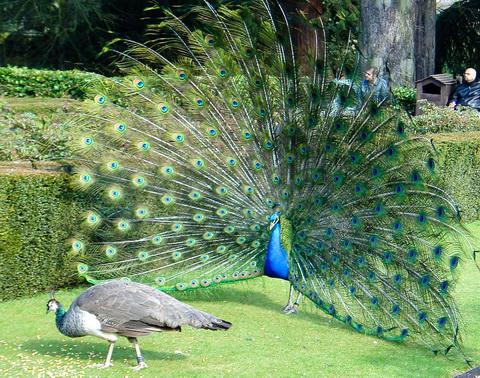
The chicks grow quickly, but to cultivate a real "adult" trail, the young peacocks takes 3 years, ie Peacocks are ready to breed only in the third year of life.
Besides ordinary (blue) peacock, which was discussed above, there are also Javanese peacock - he has a green neck, and crest of feathers on the head is not as lush and facing forward. Despite the fact that the Javanese peacock a little smaller than usual, his character is much more bad. In zoos contain Javan peacocks difficult. The males are always fighting among themselves, hurt other birds and even people rush.
8
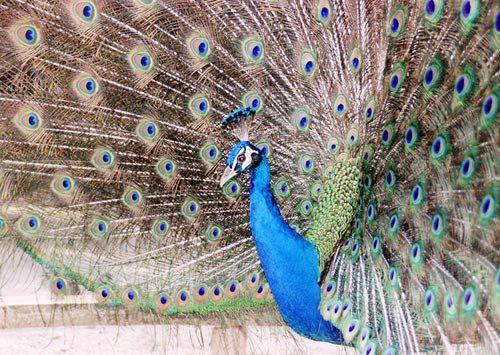
In 1936 he opened another kind of peacocks - Congolese peacock. It was hard to believe that the world still have not described by zoologists large vertebrates. It turned out that in the remote jungles, in the heart of Africa, in the Congo, is living a lot of peacocks and native tribes hunted this delicious game. However, African peacock is not as beautiful as its Asian counterparts - he does not have the luxury plume and tuft on his head modestly, but this bird belongs to the peacocks doubts among ornithologists causes.
What's creation proud,
The tail is richly expanding its,
Black and green feathers in the sparks
With loose fringe
Behind scaled breasts seem,
As a round shield Brave?
Siza azure turquoise
At each end of the pen,
Shady circles, waves are new
Struista of gold and srebro:
Tilt - Emeralds shine!
Turn - sapphires burn!
Is it not a glorious king of the feathered?
Is it not a bird of paradise Zhar,
Which is so rich piece
It leads in surprise thing?
Where to set foot - rainbow play!
Where will - there's rays around!
Of course, the strength and the guy
Eagle in her wings,
The voice of the trumpet, the swan song of
It presladostnyh lips;
A pelican virtue
In her heart and soul!
But what a wonderful phenomenon?
I hear a strange screeching!
This Phoenix dropped suddenly feathers,
Seeing the enormity feet svoih.-
About splendor! you dazzle!
And a gentleman crazy - the peacock.
Gavrila Derzhavin

Source:
Peacock - a bird which at all times was called beautiful. Iridescent blue-green plumage, a luxury long oculate fan of feathers, whip of feathers with tiny "eyes" on the head, long neck, an important step - all great peacock.

4000 years ago in ancient Babylon, Persia and Egypt, have spared no money to decorate their gardens of these wonderful birds. And they had to take them from a distance, along the Silk Road from India. It was there, in the jungle and in the bushes along the river valleys, is the birthplace of peacocks.
2

In Greece, Alexander the Great brought the peacocks from the Indian campaign. And then we began to breed peacocks in ancient Rome. And it not so proved troublesome thing - quickly breed in captivity regal birds and fried ... fell on the tables of Roman nobles.
3

In medieval Europe, breeding peacocks were not engaged, so this bird has become a rarity, was expensive, and on the dinner tables appeared only in the richest homes as evidence of the unprecedented generosity of the owner.
Then we have developed conflicting opinions about the peacock feathers.
Residents of Southern Europe believed that a spot on peacock pen is the "eye of the Lord", bringing happiness and good luck. In northern Europe, on the contrary, believed that with the peacock feathers look "devil eyes" that can bring misfortune to the one who owns them.
Hence, perhaps, the tales of ill-fated re Firebird, which, as he wrote in Yershov "Humpbacked Horse", "a lot of restlessness bring it with him ...."
4

In India, the peacock - the sacred bird. Kill the peacock - then the wrath of the gods, because this bird is devoted to Krishna, one of the most important Hindu gods. That's peacocks roam freely over cultivated fields, eating a sacrificial portion of the harvest. Even in urban India wild peacocks feel good, eagerly eating handouts devout Hindus and generous tourists.
5

And Peacock is considered the master of rain, much desired for hot India. Peacock Creek in India is perceived as "minhao", which translated means: "Rain, Go!" And indeed, as soon as the male peacocks often begin to cry, the rainy season begins.
This mystical coincidence is explained very simply - peacocks mating season, when they yell more often than usual, just coincides with the arrival of monsoon rains. It was then that it is time to demonstrate the main decoration of males - a huge fan, "plume", which wrongly called tail.
6

This peacock's tail, formed, like all birds, steering feathers, small and nevzrachen. He hides under the train long (160 cm) tail coverts, "nadhvostem." The length of the bird together with the train reaches 2 to 3 m. By the way, the peacock - one of the largest troop chick, and weighs up to 6 kg.
With a beautiful tail Peacock does not bother dancing and other tricks of seduction ladies. It is necessary to reveal the trail and peahen itself will run around the groom, wishing to see the magnificent tail. And he will turn away from it, yet bewitched wonderful train peahen will not fall down before the elect. Then he will turn his seductive tail fertilize the female, and the end of the holiday. Best female build a nest and raise offspring - 4-7 chicks.
7

The chicks grow quickly, but to cultivate a real "adult" trail, the young peacocks takes 3 years, ie Peacocks are ready to breed only in the third year of life.
Besides ordinary (blue) peacock, which was discussed above, there are also Javanese peacock - he has a green neck, and crest of feathers on the head is not as lush and facing forward. Despite the fact that the Javanese peacock a little smaller than usual, his character is much more bad. In zoos contain Javan peacocks difficult. The males are always fighting among themselves, hurt other birds and even people rush.
8

In 1936 he opened another kind of peacocks - Congolese peacock. It was hard to believe that the world still have not described by zoologists large vertebrates. It turned out that in the remote jungles, in the heart of Africa, in the Congo, is living a lot of peacocks and native tribes hunted this delicious game. However, African peacock is not as beautiful as its Asian counterparts - he does not have the luxury plume and tuft on his head modestly, but this bird belongs to the peacocks doubts among ornithologists causes.
What's creation proud,
The tail is richly expanding its,
Black and green feathers in the sparks
With loose fringe
Behind scaled breasts seem,
As a round shield Brave?
Siza azure turquoise
At each end of the pen,
Shady circles, waves are new
Struista of gold and srebro:
Tilt - Emeralds shine!
Turn - sapphires burn!
Is it not a glorious king of the feathered?
Is it not a bird of paradise Zhar,
Which is so rich piece
It leads in surprise thing?
Where to set foot - rainbow play!
Where will - there's rays around!
Of course, the strength and the guy
Eagle in her wings,
The voice of the trumpet, the swan song of
It presladostnyh lips;
A pelican virtue
In her heart and soul!
But what a wonderful phenomenon?
I hear a strange screeching!
This Phoenix dropped suddenly feathers,
Seeing the enormity feet svoih.-
About splendor! you dazzle!
And a gentleman crazy - the peacock.
Gavrila Derzhavin

Source:


